December 19, 2011
Officials with the City of Los Angeles say the city is meeting its obligations for water flow down the Lower Owens River, but there is room for improvement in the surrounding areas.
In accordance with the Inyo-L.A. Long-Term Water Agreement, the Los Amgeles Department of Water and Power released its annual Lower Owens River draft report earlier this month, outlining efforts in the past year to restore the river and surrounding habitat.
The LADWP is scheduled to hold a public information meeting to discuss the report at 10 a.m. this coming Tuesday, Dec. 20, at the LADWP offices on Mandich Street Bishop.
The overall goal of the LORP, as stated in a 1997 Memorandum of Understanding between the LADWP and Inyo County, is “establishment of a healthy, functioning Lower Owens River riverine-riparian ecosystem, and the establishment of healthy, functioning ecosystems in the other physical features of the LORP, for the benefit of biodiversity and threatened and endangered species, while providing for the continuation of sustainable ecosystem.”
LORP implementation included release of water from the L.A. Aqueduct to the Lower Owens River and flooding of up to approximately 500 acres of surrounding land.
The project also outlines maintenance requirements of several off-river lakes and ponds, modifications to land management practices and construction of new facilities including a pump station to capture a portion of the water released to the river.
According to the report, the LADWP met all court mandates for water flows (40 cubic feet per second) on the LORP for 2010-11 and met requirements for seasonal habitat flows.
The department said seasonal habitat flows lasted 15 days and six hours, and resulted in the intentional flooding of approximately 1,636 near the lower Owens.
“During the seasonal habitat flow about 77 percent of floodplains and 29 percent of low terraces in the Lower Owens River were inundated,” the draft report states. “Seasonal Habitat Flow flooded extent this year was similar to the 200-plus cfs flow in 2010.”
Overall, the LADWP says it is meeting the goals set forth for the LORP in the 1997 MOU with Inyo County.
“As in 2010, monitoring analysis indicates that the LORP is attaining many MOU goals. The LORP already supports a healthy warmwater fishery in all reaches. Habitat for all indicator species has developed and continues to develop,” the report states. “Biodiversity in wetlands and riverine habitats has increased. Grazing and other land uses are continuing, and recreational activities continue to increase.”
Though the LADWP boasts of many successes in its report, it also points out that there is room for improvement and recommended a number of adaptive management techniques for base flows and seasonal habitat flows, tule encroachment, future water quality, beaver abundance and woody riparian plant development.
The Inyo County-Los Angeles Technical Group is scheduled to discuss the draft report Jan. 18.
The LADWP is releasing the draft report both in hard copy and online to ensure it is available to all who wish to read the full, 200-plus page document.
To pick up a hard copy, go to the LADWP offices at 300 Mandich St. in Bishop. For a digital copy, visit http://www.ladwp.com/ladwp/cms/ladwp014969.pdf

